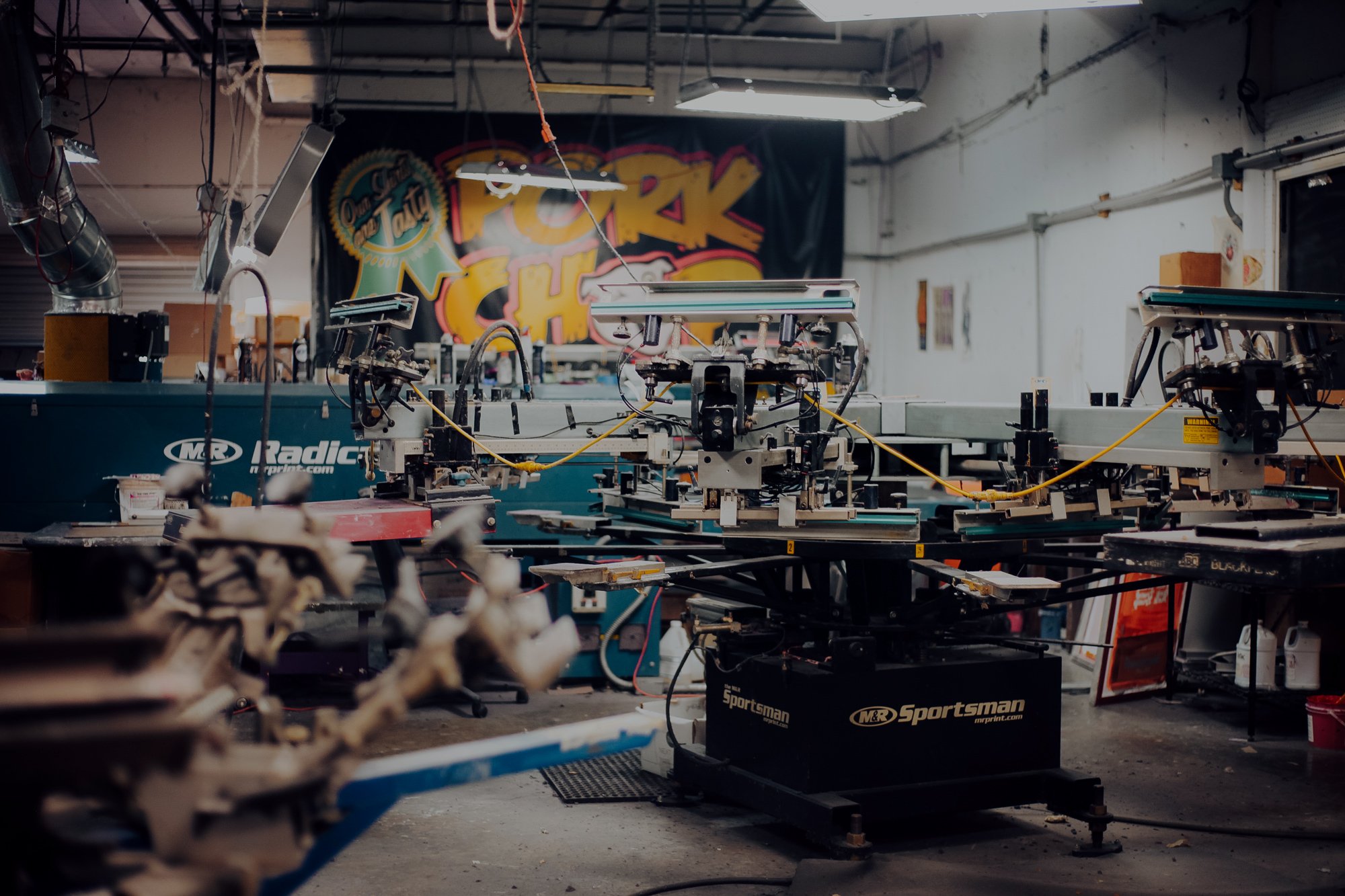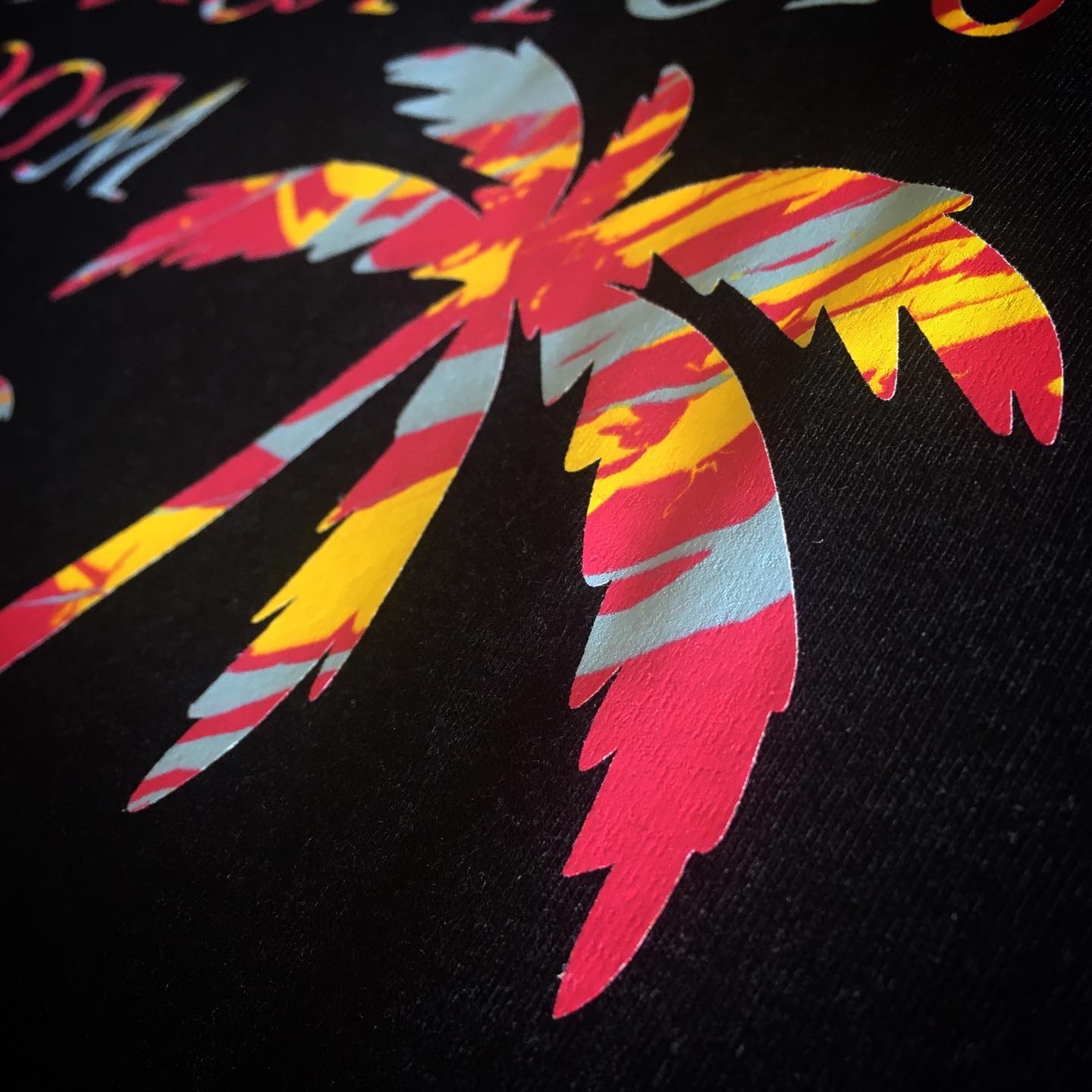High-Quality Custom Screen Printing for Team Apparel
High-Quality Custom Screen Printing for Team Apparel
Blog Article
Display Printing Uncovered: Whatever You Need to Find Out About Tee Shirt and Garment Printing Strategies
Display printing is a fascinating method that combines art with method, providing countless opportunities for imagination. Prepared to discover the necessary elements that make screen publishing an art kind?
The Fundamentals of Screen Printing: Just How It Functions
When you plunge right into screen printing, you'll uncover it's both an art and a scientific research. At its core, screen printing entails developing a pattern, or display, that permits ink to travel through only in certain locations (screen printing kit). You start by selecting your layout and preparing your screen with a light-sensitive emulsion. Once you subject this solution to light, it hardens, leaving your style as a negative area.
Following, you'll mix your inks and prepare your printing surface area. Position the screen over the textile, after that use a squeegee to push ink with the display onto the garment. This procedure requires accuracy, as you want clear, lively prints. After printing, you'll cure the ink with warm, ensuring it adheres to the material and lasts with cleans. Each step is vital, and understanding them will raise your screen printing abilities, changing basic garments right into unique, expressive pieces.
Kinds Of Display Printing Techniques
Once you realize the fundamentals of screen printing, it's time to check out the numerous methods that can elevate your layouts. One popular approach is typical display printing, where ink is pressed through a stenciled display.
If you're going for great information, take into consideration discharge printing. This strategy eliminates dye from the fabric, leaving a soft, classic appearance. One more option is plastisol printing, understood for its longevity and dazzling colors, making it a favorite for many brand names. Lastly, try out halftone printing to create slope impacts and elaborate designs. Each strategy has its one-of-a-kind beauty, so don't wait to try them out to discover what suits your design best!
Necessary Equipment for Display Printing
To achieve magnificent cause display printing, having the ideal equipment is basic. Initially, you'll need a strong display printing structure, which holds the mesh that transfers your layout onto the garment. Next, invest in top quality mops; these are important for using ink equally across the display. You'll also need a good direct exposure device to create your screens, along with a washout booth for cleansing them after use. A dependable heat source, like a conveyor clothes dryer or heat press, is crucial for curing your prints to assure long life. Do not fail to remember a proper workspace, furnished with tables and storage for your supplies. Safety equipment, such as handwear covers and masks, will certainly maintain you secure from chemicals and inks. With the right devices, you'll be well on your means to generating professional-quality prints.
Choosing the Right Inks and Products
When picking inks and materials for screen printing, you need to think about the sort of ink that works best for your task. Assume concerning textile compatibility to assure your styles look great and last lengthy. Additionally, check out eco-friendly ink alternatives to make your printing procedure a lot more sustainable.
Kinds of Display Inks
Selecting the best screen ink is vital for achieving dynamic, resilient prints that meet your job's needs. There are numerous sorts of display inks to check out. Plastisol ink is prominent for its versatility and convenience of use, providing superb shade opacity on dark materials. Water-based ink, on the other hand, supplies a softer feeling and is environment-friendly, making it perfect for those wanting to decrease their environmental influence. Discharge inks remove color from the material, causing a soft, classic appearance however call for particular handling. Finally, specialty inks, such as glow-in-the-dark or metallic, can include one-of-a-kind impacts to your layouts. Review your project demands and pick the ink that aligns finest with your wanted outcome.

Material Compatibility Factors To Consider
Recognizing material compatibility is crucial for accomplishing top notch display prints, particularly because different materials respond distinctly to numerous inks. When picking inks, take into consideration the textile kind-- cotton, polyester, or blends. For cotton, water-based inks work well, providing gentleness and breathability. Polyester, on the other hand, frequently requires plastisol inks for much better bond and dynamic colors. If you're printing on blends, you might require to make use of a combination of both kinds. Always test your inks on example material to guarantee they stick correctly and maintain shade integrity. In addition, bear in mind that textile weight and structure can affect the last result, so picking the ideal ink and material combination is important for your task's success.
Eco-Friendly Ink Options
Eco-friendly inks home are ending up being a prominent choice for screen printers who want to lessen their environmental effect while keeping top quality. When selecting inks, my sources think about water-based inks, which are much less damaging and easier to clean up contrasted to traditional solvents.
Furthermore, seek inks made from renewable energies, such as soy or vegetable-based options. By choosing the best inks and products, you'll not just create sensational styles however likewise contribute to a more lasting printing procedure. Make the button, and your prints will show your commitment to the environment!
Preparing Your Layout for Display Printing

Submit Style Needs
To ensure your style looks sharp and vivid on textile, you'll require to pay very close attention to file style demands for display printing. Begin with vector data like AI or EPS, as they can be scaled without shedding top quality. If you make use of raster pictures, go with high-resolution files, such as TIFF or PNG, preferably at 300 DPI. Stay clear of making use of JPEGs, as they can lose clearness when resized. Make sure your design has a clear history to protect against undesirable white edges on your prints. Ultimately, keep color settings in mind; CMYK is standard for screen printing, so convert your RGB designs as necessary. By following these standards, you'll establish your artwork up for a successful print.
Shade Splitting Up Techniques
Color splitting up is an important action in preparing your style for display printing, and grasping it can significantly improve your print top quality. You'll require to break your design right into private shades, as each color needs a separate display during printing. Beginning by determining all the colors in your layout and create layers for each one. You can use software program like Adobe Photoshop or Illustrator to isolate and separate colors efficiently. Be specific to save each layer as a different documents, generally in a layout like TIFF or PSD. This accuracy not only assures accurate shade representation yet also simplifies the printing process. By taking note of color separation, you'll achieve professional and vivid cause your screen-printed garments.
Resolution and Size
Attaining the most effective results in screen printing begins with guaranteeing your layout has the best resolution and dimension. Preferably, your artwork needs to be at the very least 300 DPI (dots per inch) for sharp, clear prints. If you utilize reduced resolution, your final item might look amateur and pixelated.
When it comes to size, take into consideration the dimensions of your print location. Design your artwork to match the last print size, ideally creating it in the real dimensions you'll be printing. In this manner, you'll avoid any kind of unforeseen scaling problems.
Constantly check your layout in both vector and raster layouts. Vector graphics can be scaled without shedding quality, making them excellent for display printing. Preparing correctly will ensure your style looks remarkable on every garment!
Step-by-Step Display Printing Refine
Screen printing is a vibrant process that allows you to produce dynamic layouts on various surface areas. To obtain begun, you'll need a display, solution, and your selected ink.
After rinsing the unexposed solution, your screen prepares. Set it up on your printing surface area and straighten your garment underneath it. Pour ink onto the display and use a squeegee to push the ink through the stencil onto the textile. Raise the screen very carefully and let the print completely dry. Finally, cure the ink using warmth to ensure durability. That's it! You've efficiently display printed your design.
Tips for Effective Display Printing Projects
While you're diving into your site screen printing projects, remember that preparation is key to success. Start by gathering all your products-- inks, screens, garments, and mops. A tidy workspace aids avoid undesirable errors, so neat up before you start.
Following, confirm your art work is high-resolution and appropriately sized for your garment. Test your display for proper direct exposure and tidy it completely to stay clear of smudges. When blending your inks, follow the maker's guidelines to accomplish the appropriate consistency.
Throughout printing, apply also pressure with your squeegee for consistent outcomes. Don't hurry; take your time to verify each print fulfills your requirements. After printing, let your garments completely dry entirely before managing or packaging them.
Lastly, always maintain a sample of your work for future referral. In this manner, you can assess your development and boost your techniques gradually. Happy printing!

Often Asked Concerns
How much time Does It Take to Establish a Screen Printing Job?
Setting up a screen printing job normally takes around 30 minutes to an hour. You'll prepare the screens, mix inks, and readjust journalism. The time differs based upon intricacy and experience, so stay arranged!
Can I Print on Various Fabric Types Making Use Of the Very Same Method?
Yes, you can print on different fabric types making use of the very same method, however you'll need to change your settings and inks. Some materials take in ink in a different way, so exploring guarantees the very best results for every product.
What Are Common Blunders to Avoid in Display Printing?
When screen printing, prevent common blunders like utilizing the incorrect ink, ignoring proper direct exposure times, or skipping pre-press checks. Always test your configuration and maintain clean displays to assure quality outcomes each time.
Just How Can I Appropriately Tidy and Keep My Display Printing Tools?
To appropriately clean and keep your screen printing equipment, you should regularly clean displays with ideal solvents, examine squeegees for wear, and assure all devices are stored completely dry and dust-free. Consistency improves and stops pricey fixings efficiency.
Is Display Printing Eco-friendly Contrasted to Various Other Techniques?
Display printing can be extra ecologically friendly than other approaches, especially if you utilize water-based inks and eco-conscious products. By choosing sustainable products and practices, you lower waste and minimize your influence on the earth.
Display Printing Uncovered: Whatever You Required to Know Concerning T-Shirt and Garment Printing Methods
At its core, display printing includes developing a stencil, or display, that enables ink to pass with only in details areas. Setting the screen over the material, then make use of a squeegee to push ink via the screen onto the garment. One prominent approach is standard screen printing, where ink is pressed through a stenciled screen.When picking inks and materials for screen printing, you need to take into account the type of ink that works ideal for your job.
Report this page